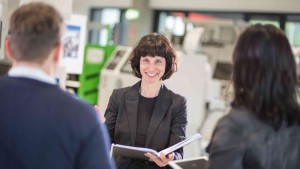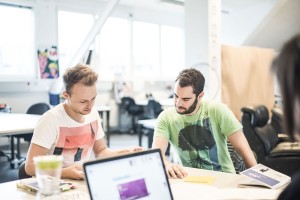We want to support diversity and meet people of all genders on an equal footing. Therefore, we have set two measures to make FH JOANNEUM a more discrimination-free and gender-inclusive place.
As a University of Applied Sciences, FH JOANNEUM has an educational policy mandate to counteract inequalities of opportunity and support diversity. This means encountering all people who are connected to the university in a variety of ways in a non-discriminatory and gender-inclusive manner.
More than man and woman.
Gender is diverse and as individual as a fingerprint. Bodies cannot be classified into strict gender categories, and gender cannot be defined by physical characteristics alone. Gender is a continuum, much broader and more diverse than the binary poles of man and woman.
For many people, their gender self-concept (gender) matches the sex they were assigned at birth (sex). They are cisgender, or cis for short.
Intersex people do not develop all gender-defining characteristics as medically distinctly female or male. Some intersex people refer to themselves as inter, others as women or men.
Not all people can or want to live in the gender to which they were assigned at birth based on physical characteristics. These people see themselves as transgender. Being trans means that one's gender self-concept (gender) does not match the sex assigned at birth (sex).
Non-binary people find no place in the binary, purely bisexual assignment of male and female and have diverse identities. That is, social gender is not exclusively male or female, but can also be understood as asexual, multisexual, or another gender.
Gender diverse people work and move in all areas of society and so too at our university. As an open university, we want to meet all people on an equal footing.
By this we mean the use of non-discriminatory and gender-inclusive language and also toilet facilities that are accessible to all people, regardless of gender.
One toilet for All
In addition to toilets that are still divided into binary spaces for men and women, you will also find All Gender toilets in all our buildings at all locations. They can be used by everyone, regardless of which gender they (don't) assign themselves to. No one should feel uncomfortable or have to avoid going to the bathroom. No one should fear slanted looks, attacks, or even being turned away at the restroom door on their way to the restroom. All Gender Restrooms are not just about going to the bathroom, they are about visibility, safety and promoting equality.
In the future, All Gender Restrooms will also include diaper-changing tables and free menstrual product dispensers.
One Language for All
Gender-appropriate language and communication creates encounters at eye level and equal space for all genders. In any case, such language helps respect and acknowledge the existence of gender diverse people. To help you use non-discriminatory language, we have developed the gender-responsive language guide. It contains introductory information around gender diversity and legal background information around gender, as well as concrete examples of how to use gender-inclusive or gender-neutral language. You will find our recommendations for gender-equitable language use here soon.









